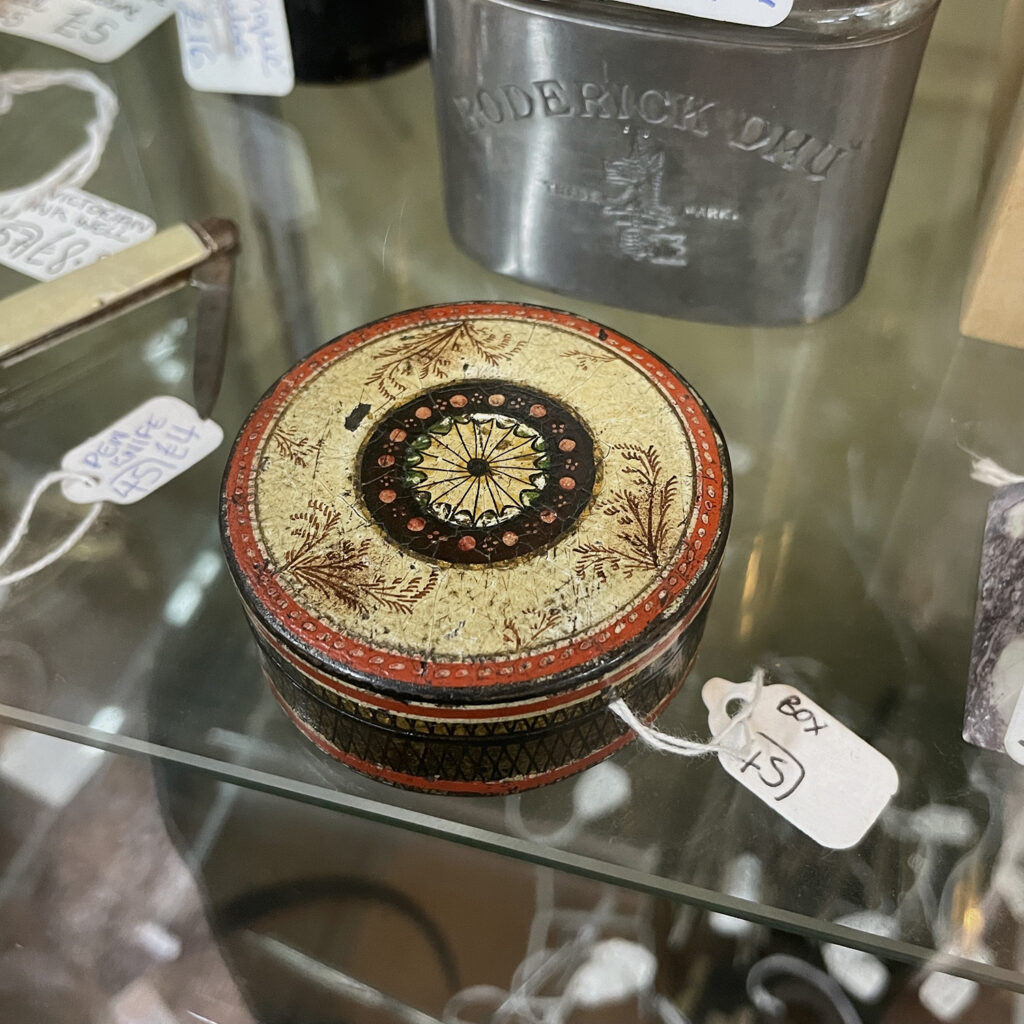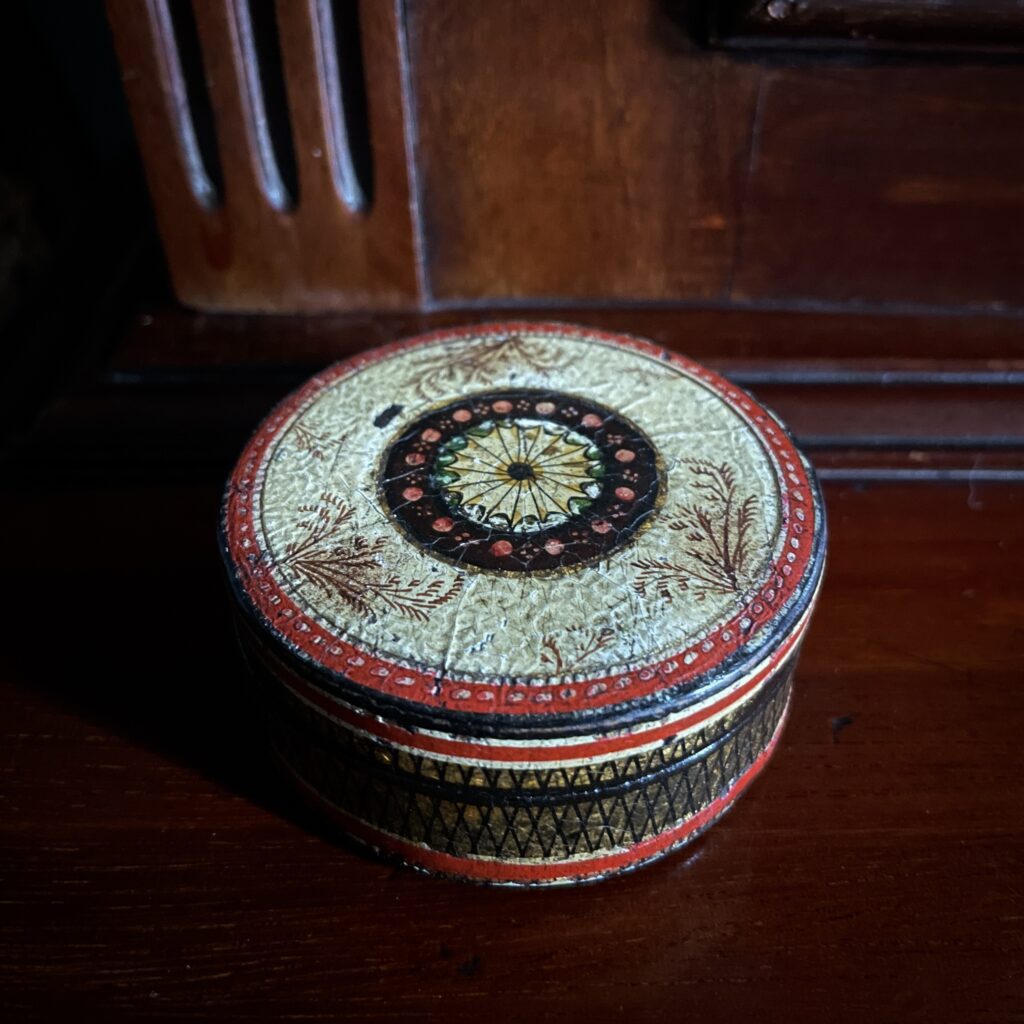I love Snoopers’ Paradise. A visit to Brighton and the famous ‘Lanes’ isn’t complete with out it. I rarely leave that sprawling, 7,000 square foot indoor fleamarket without adding something new to my collection. As ever, I found so many things there on the last bank holiday weekend, but my heart skipped a little beat when I saw something simply described as ‘Box’.

It spoke to me and there’s so much more behind it than the minimally descriptive description suggests. At 2.25in (6cm) in diameter, it was made from papier mâché which was then handpainted with a pattern, probably sometime around the late 18th century or early 19th century. One often sees pastoral or other scenes containing people on such things, but this geometric design appealed to me more. The lid has a circle containing what looks a little like an architectural feature – like looking up into the middle of a dome from below, or a full Georgian fanlight window. That’s surrounded by a ring of dots alternating with a four dot motif. Around that, ferny fronds grow across a beige ground, within an outer red ring with gilt lines and dashes. The sides and base are embellished with a black criss-cross pattern on a mottled gilt background, and more red and gilt bands. SO. MUCH. WORK. There’s wear and tear, suggesting it was much used – and much loved.
What was it for?
It could have had two uses. Firstly, it could have been a ‘patch box’. A patch (or mouche) was a tiny piece of fabric that was glued on to the face to hide facial scars or blemishes, often caused by smallpox. A form of cosmetic, they also highlighted the fashionable paleness of one’s (maybe powdered) skin. Patches began to be used in the 1500s, the fashion grew during the 18th century led by the French Royal Court, and they continued to be used into the 19th century. Sometimes patches were shaped like hearts or triangles, and there was even a ‘language of the patch’, where messages could be conveyed by where the patch was placed on the face. Patches were stored in a small patch box on a dressing table.
Or it could be a snuff box. The snorting of finely ground tobacco leaves became fashionably widespread by the 17th century, reached the peak of its popularity in the early 18thC, and began to wane from general use as 19th century progressed. At the height of its popularity, so many people across all levels of society owned decorative boxes (typically airtight) to store their snuff in. ‘Snuff said. My box has a slight tobaccoey smell, indicating the latter, but it may possibly have been a patch box before.

Quanto Costa?
So we have wonderful craftsmanship and visual appeal in terms of decoration (how much would that cost to make today?) and a fascinating social story and cultural connections. So how much did it cost? Twenty quid. Yes, £20 – or €23, or $28. In tangible terms, a round or so at the local bar. How can a unique, personal, handmade thing like this that’s over two centuries old be so cheap?
And the local bar is exactly where my partner and I went next – Revenge on Brighton seafront, to be precise. A drink or two later, while examining my new treasure, we were ready to head home so I excused myself to pop to the loo. When I came back to our table, it had been dutifully cleared and cleaned. But where was the small brown paper package containing my centuries old box, so carefully kept by its previous owners? Gone! Enter the wonderful Ex-Girlfriend, the drag queen host for the afternoon. Like a heat-seeking missile in (rather glamorous) slingbacks, she was off to the bin and returned in milliseconds clutching my package. Heroine of the day!! When I explained what she had rescued, she was horrified, as the photo shows…

Painstakingly painted for hours, used for decades, treasured for centuries, bought for less than the cost of our drinks – and then lost and found in mere minutes. I wonder what its original Georgian owner would have thought of all this?!
P.S.; Fear not, dear reader, our intrepid Georgian box is now safely stowed on my desk, where it contains my rings when I take them off to type. It’s a lovely and useful thing to have on my desk!

